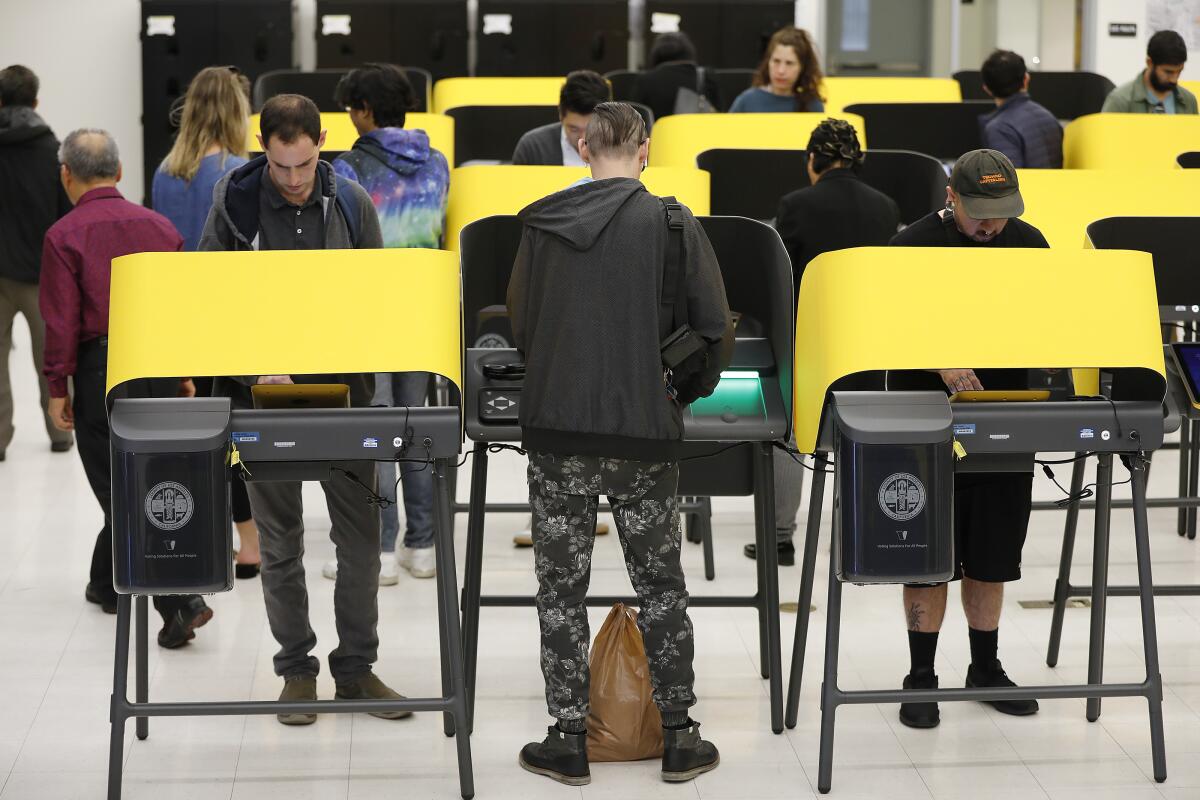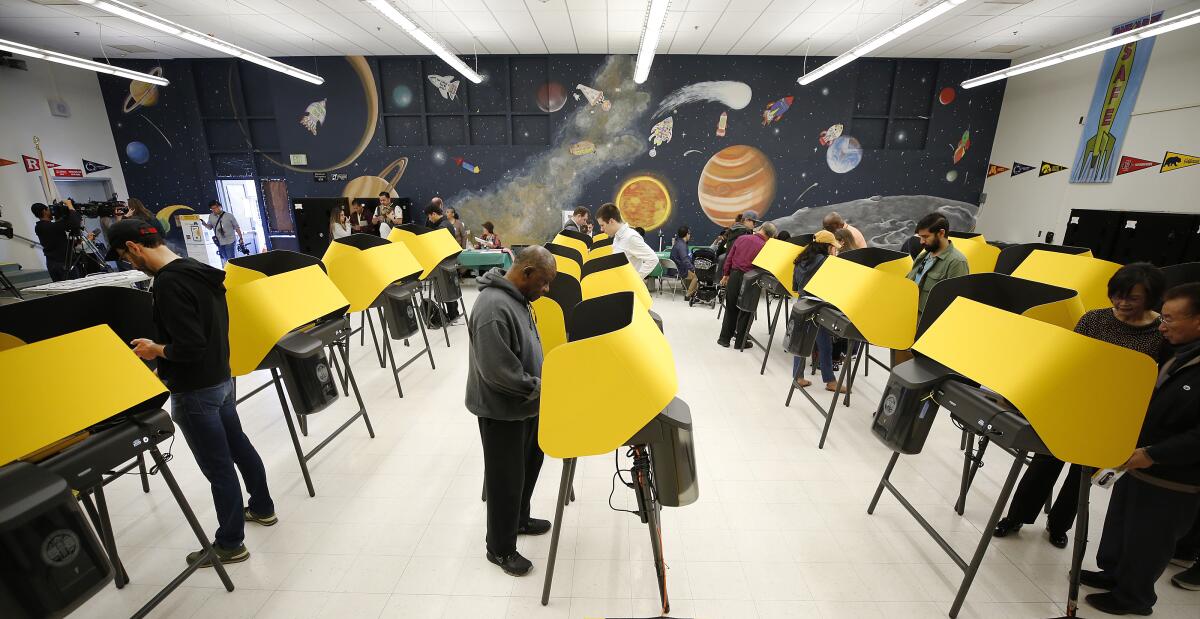Prop. 13 school bond measure appears headed for defeat. How did that happen?

A combination of confusing messages and an unfortunate name contributed to what appears to be the first failure of a state school bond measure in a quarter of a century, education and public policy experts said Wednesday.
Proposition 13 would have raised $15 billion from general obligation bonds for preschools, K-12 schools, community colleges and state universities. Although ballots were still being counted in Los Angeles County and the statewide tally is not complete, the ‚Äúno‚ÄĚ vote led, 56% to 44%, with virtually all precincts reporting at least partial numbers, according to the California secretary of state.
‚ÄúIt‚Äôs certainly one of the big surprises of last night that a state bond on a ballot in ... the Democratic presidential primary with Bernie Sanders leading all the other candidates failed to reach majority support,‚ÄĚ Mark Baldassare, president of the Public Policy Institute of California, said Wednesday.

Baldassare said that high Democratic turnout and a good economy were expected to help the measure, and that historically voters have supported funding for schools. The last time a school bond failed was in 1994.
‚ÄúThe first question that I have ... is, is the fact that the bond measure failed some indication of nervousness that voters are having about the economy?‚ÄĚ he said.
The measure ‚ÄĒ which had no relation to the landmark 1978 Proposition 13 that capped property tax increases ‚ÄĒ would have funded safety repairs, lead testing and remediation, and construction of new classrooms, among other school projects. Nine billion dollars would have gone to preschool through K-12 schools, with priority given to districts that were unable to raise money locally and served high shares of low-income students, English-language learners, and foster youth. The remaining $6 billion would have been split evenly among community colleges and the Cal State and University of California systems.
In the weeks leading up to the vote, a statewide survey by the Public Policy Institute of California showed that only a slim majority, 51%, of likely voters supported Proposition 13. Of those, fewer than half said the outcome was ‚Äúvery important‚ÄĚ to them, which Baldassare said may have indicated a lack of urgency around the measure.
Others said that the name of the measure and confusion about its effect on property taxes led to its demise.
‚ÄúThere‚Äôs no other proposition number in the history of California that resonates in voters‚Äô minds like 1978‚Äôs Proposition 13. It‚Äôs notorious and infamous,‚ÄĚ said Jeff Vincent, a director at the Center for Cities and Schools at UC Berkeley.
Compounding the confusion is a measure that appears headed for the November ballot that would modify the original Proposition 13 by making it easier to raise commercial property taxes to fund schools and other local services.
‚ÄúSo you have various mailers and messaging talking about Prop. 13 ... but they‚Äôre different Prop. 13s,‚ÄĚ Vincent said. ‚ÄúConfusion is the friend of the ‚Äėno‚Äô vote.‚ÄĚ
On Wednesday, Assemblymember Patrick O‚ÄôDonnell (D-Long Beach), who co-authored the bill that put the bond on the ballot, announced that he will introduce legislation to retire the use of the number 13 on future ballot measures ‚Äúto ensure voters are not misled.‚ÄĚ
Opponents of the school bond measure attacked it by focusing on the possibility that it could pave the way for local property taxes to go up, capitalizing on California residents’ worries over housing costs and property taxes in an already expensive state.
A provision in the measure would have increased the amount school districts could borrow through local bonds, which require voter approval and are repaid by property owners. The $15 billion in general obligation bonds, however, would have been paid back, with interest, out of the state’s general fund over 35 years, without adding a new tax on voters.
The Howard Jarvis Taxpayers Assn., named for the man behind the original Proposition 13, was the only registered opposition to the bond and seized on the possibility of increased local bonds in its messaging.
‚ÄúIn social media this was blasted all over the place,‚ÄĚ said Jeff Freitas, president of the California Federation of Teachers, which endorsed the measure. ‚ÄúThere‚Äôs a lot of misinformation out there, and that‚Äôs what the opponents wanted.‚ÄĚ
The measure may also have suffered from a lack of key support, observers said. Los Angeles Unified School District ‚ÄĒ the largest district in the state, located in the most populous county ‚ÄĒ did not campaign in favor of the measure, which may have offered only limited aid to the district while reducing some of the revenue it takes in from developer fees paid to the district when new multi-family housing is built.
‚ÄúWas there an effort to convince L.A. voters?‚ÄĚ Baldassare asked. ‚ÄúYou need those trusted voices.‚ÄĚ
More to Read
Sign up for Essential California
The most important California stories and recommendations in your inbox every morning.
You may occasionally receive promotional content from the Los Angeles Times.





![[20060326 (LA/A20) -- STATING THE CASE: Marchers organized by unions, religious organizations and immigrants rights groups carry signs and chant in downtown L.A. "People are really upset that all the work they do, everything that they give to this nation, is ignored," said Angelica Salas of the Coalition of Humane Immigrant Rights. -- PHOTOGRAPHER: Photographs by Gina Ferazzi The Los Angeles Times] *** [Ferazzi, Gina -- - 109170.ME.0325.rights.12.GMF- Gina Ferazzi/Los Angeles Times - Thousands of protesters march to city hall in downtown Los Angeles Saturday, March 25, 2006. They are protesting against House-passed HR 4437, an anti-immigration bill that opponents say will criminalize millions of immigrant families and anyone who comes into contact with them.]](https://ca-times.brightspotcdn.com/dims4/default/34f403d/2147483647/strip/true/crop/1983x1322+109+0/resize/840x560!/quality/75/?url=https%3A%2F%2Fcalifornia-times-brightspot.s3.amazonaws.com%2Fzbk%2Fdamlat_images%2FLA%2FLA_PHOTO_ARCHIVE%2FSDOCS%2854%29%2Fkx3lslnc.JPG)






